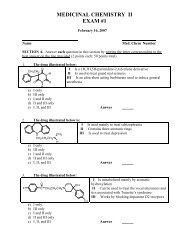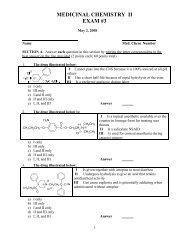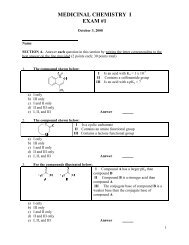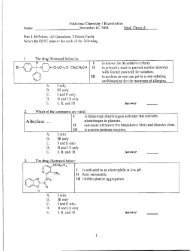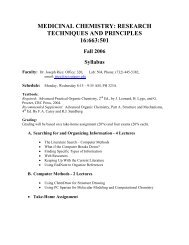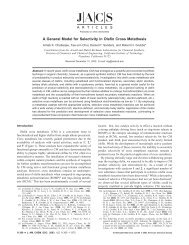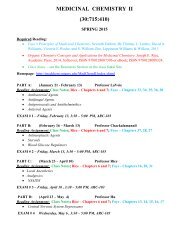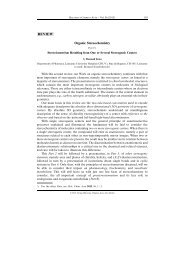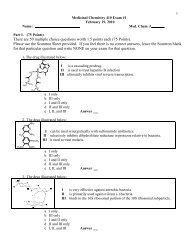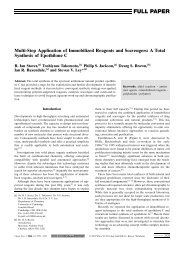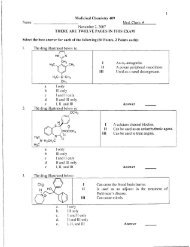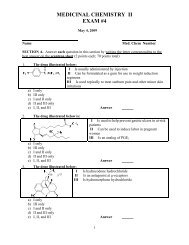Baldwin's Rules - Department of Medicinal Chemistry
Baldwin's Rules - Department of Medicinal Chemistry
Baldwin's Rules - Department of Medicinal Chemistry
You also want an ePaper? Increase the reach of your titles
YUMPU automatically turns print PDFs into web optimized ePapers that Google loves.
Chemical Reviews REVIEW<br />
Table 2. Reaction Energies, Attack Angles, and LUMO Plots<br />
Visualizing the Arrangement <strong>of</strong> Alkyne π*-Orbital and<br />
Nucleophile Lone Pair for the Parent Anionic Additions to<br />
Acetylene at the B3LYP/6-31+G(d,p) and M05-2X/6-31<br />
+G(d,p) Levels <strong>of</strong> Theory a<br />
a M05-2X data are given in parentheses.<br />
strained “convergent” pattern is inconsistent with the suggested<br />
preference for the acute trajectory (Figure 4).<br />
The proposed digonal trajectory also does not satisfy the<br />
stereoelectronic requirements for nucleophilic attack at a π-bond.<br />
Basic MO considerations suggest that a better trajectory for<br />
attack at the alkyne π*-orbital is provided by the obtuse approach,<br />
analogous to the B€urgi Dunitz trajectory for trig cyclizations<br />
(Figure 6). Indeed, a substantial body <strong>of</strong> experimental and computational<br />
evidence supports this notion, indicating that the<br />
Baldwin rules for alkynes need to be redefined (vide infra).<br />
In an early computational challenge to the acute attack<br />
trajectory, Strozier, Carmella, and Houk calculated transition states<br />
for the attack <strong>of</strong> a hydride anion at acetylene and ethylene. 21 Not<br />
only were the transition state energies found to be very similar for<br />
acetylene and ethylene (16.7 and 16.6 kcal/mol) but the angle <strong>of</strong><br />
attack was also found to be quite similar for the two substrates, with<br />
a CC-Nuc angle <strong>of</strong> 127° and 124°, respectively, 22 very different<br />
from the 60° acute attack suggested by Baldwin. 4<br />
Recent higher level calculations 23 have not changed this alternative<br />
stereoelectronic preference, providing further support to<br />
the notion that the obtuse geometry provides the best trajectory<br />
for nucleophilic attack at the triple bond and that TS geometries<br />
for nucleophilic addition to alkynes and alkenes are generally<br />
similar.<br />
The representative intermolecular attack angles by three<br />
nucleophiles (CH3 , NH2 , OH ) on the triple bond <strong>of</strong><br />
ethyne are shown in Table 2. 24 Athough the angle changes from<br />
∼115 o to 130° with the transition from an early TS to a late TS, all<br />
data agree with the intrinsic stereoelectronic preference for obtuse<br />
attack.<br />
The obtuse nucleophilic attack trajectory is also supported by<br />
basic stereoelectronic considerations, as this approach avoids the<br />
interaction <strong>of</strong> incoming nucleophiles with the nodal plane <strong>of</strong><br />
π*-orbital. If this analysis is applied to the intramolecular nucleophilic<br />
attack at the alkyne moiety (aka nucleophilic dig-cyclization), the<br />
obtuse trajectory should be translated into stereoelectronic preference<br />
for the exo attack, in close analogy to that <strong>of</strong> trig-cyclizations.<br />
It is also important to note that alkynes have two orthogonal<br />
π-bonds, thus alleviating the need for the nucleophile to deviate<br />
out <strong>of</strong> plane in order to reach the ideal B€urgi Dunitz attack at<br />
Figure 5. Stereoelectronic differences between alkenes and alkynes<br />
arising from the presence <strong>of</strong> the in-plane π-system in alkynes.<br />
the π*-orbital. Instead, the incoming reactive center (radical,<br />
cation, anion, radical-cation, radical-anion) can attack the in-plane<br />
π-bond, thus, avoiding the additional distortion penalty inherent<br />
to, for example, the 5-endo-trig process (Figure 5).<br />
Alabugin, Gilmore, and Manoharan have recently examined<br />
the stereoelectronics <strong>of</strong> ring closures onto terminal and substituted<br />
alkynes for carbon and heteroatom anions and radicals. 24<br />
It was observed that as the linker length increases, the obtuse<br />
angle <strong>of</strong> the exo attack decreases from 140° (3-exo) to 116° (5-exo)<br />
for carbanions, approaching the angle <strong>of</strong> intermolecular attack<br />
(Table 2).<br />
For the endo attack in small cycles, the cyclic constraints impose<br />
an acute angle <strong>of</strong> nucleophilic attack (76° for 4-endo and 82°<br />
for 5-endo closures). As the cycle size increases, the angle <strong>of</strong> attack<br />
changes to a more favorable obtuse approach in 6-endo-dig closure<br />
(99°). As expected, 4-endo and 5-endo cyclizations have much<br />
earlier transition states than the less exothermic competing<br />
exoclosures.<br />
At the same time, the incipient C 333 C distance increases in<br />
the exo-series, indicating earlier transition states for the more<br />
exothermic cyclizations (3-exo < 4-exo < 5-exo). As will<br />
be discussed individually below, comparison <strong>of</strong> the intrinsic<br />
energies 25 shows that, in every case, independent <strong>of</strong> the nature<br />
<strong>of</strong> nucleophile and alkyne substitution, exo cyclizations have<br />
lower intrinsic barriers than their endo competitors. Interestingly,<br />
the intrinsic exo barriers change relatively little (12 16<br />
kcal/mol), indicating that such variations in the attack trajectory<br />
are well tolerated. 24<br />
2.4. Differences Between Nucleophilic, Radical, and Electrophilic<br />
Trajectories<br />
Another potentially controversial aspect <strong>of</strong> the Baldwin rules is<br />
whether their utility extends beyond nucleophilic closures.<br />
Although Baldwin mentioned in his seminal paper that this<br />
treatment “also applies to homolytic and cationic processes”, 4<br />
this statement is valid only in the most general sense as a<br />
suggestion that basic stereoelectronic premises based on favorable<br />
trajectories would exist for other reactive intermediates.<br />
However, one cannot simply “transfer” the guidelines, because<br />
the very nature <strong>of</strong> bond-forming interactions that define the<br />
favorable trajectories depends strongly on the attacking species.<br />
For example, the ubiquitous cationic 1,2-shifts involved in the<br />
textbook Wagner Meerwein rearrangements are topogically analogous<br />
to the anionic 3-endo-tet process. Although the anionic<br />
processes are clearly unfavorable as illustrated by the nonconcerted<br />
nature <strong>of</strong> the [1,2]-Wittig and related anionic rearrangements, 26<br />
the ubiquity <strong>of</strong> cationic processes shows that frontside approach is<br />
allowed for electrophilic attack at a σ-bond.<br />
Why do the stereoelectronic requirements differ for nucleophilic<br />
and electrophilic attacks? As discussed above, the most<br />
important stabilizing two-electron interaction for a nucleophilic<br />
attack is the interaction <strong>of</strong> nucleophile’s HOMO with the<br />
E dx.doi.org/10.1021/cr200164y |Chem. Rev. XXXX, XXX, 000–000



